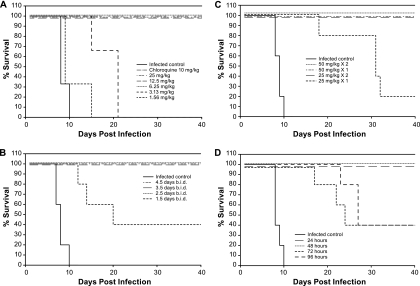Fig 2.
Oral administration of MK-4815 is efficacious in a mouse model of P. berghei infection. In each panel, BALB/c mice were infected by i.p. injection of 106 P. berghei-infected RBCs. MK-4815 formulated in 10% DMSO was dosed orally as described below. Sham-treated animals were dosed with vehicle. (A) Efficacy of MK-4815 in a dose-titration study. P. berghei-infected animals were treated with a single dose of compound on the day of infection (2 h postinfection) and then twice daily (b.i.d.) for the following 4 days (a total of nine treatments). MK-4815 was given at 25, 12.5, 6.25, 3.13, or 1.56 mg/kg (three mice per treatment group). Chloroquine was included as a positive control, using a once-a-day dose of 10 mg/kg for 5 days beginning on the day of infection. (B) Number of MK-4815 treatments, at a dose of 12.5 mg/kg, required for in vivo efficacy. Parasite-infected animals (five per group) were treated with 12.5 mg/kg MK-4815 once on the day of infection (2 h postinfection) and then twice daily for 1 (1.5 doses, a total of three treatments) to as many as 4 subsequent days (4.5 doses, a total of nine treatments). An additional treatment group received MK-4815 at 12.5 mg/kg once daily for 4 days beginning on the day of infection. (C) A single p.o. MK-4815 treatment at 50 mg/kg is sufficient for efficacy in the animal model. P. berghei-infected mice (five per group) were treated with either a single oral dose of MK-4815 (administered at 2 h postinfection) or two doses administered 24 h apart. Treatment groups included MK-4815 at 50, 25, or 12.5 mg/kg. (D) Efficacy of MK-4815 in a delayed-therapy study. Parasite-infected mice (five per group) were treated with a single 50-mg/kg oral dose of MK-4815 at 2, 24, 48, 72, or 96 h postinfection.

